Monthly Archive: June 2014
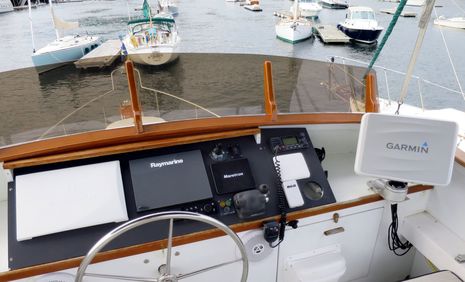 Redoing almost all of Gizmo’s electronics has taken longer than I would have guessed last fall, when it seemed like a good idea to rip everything off the boat. And sadly I’m not done yet. But the hoped-for glass bridge theme is revealing itself and I like it a lot. But then again new equipment and even just re-installed old gear also means fresh opportunities for things not to work together correctly. In this entry I’ll go over much of Gizmo’s test setup for the next year and a half — though by design there’s room for more — and also note a couple of features that have worked well and not so well during recent shakedown cruises…
Redoing almost all of Gizmo’s electronics has taken longer than I would have guessed last fall, when it seemed like a good idea to rip everything off the boat. And sadly I’m not done yet. But the hoped-for glass bridge theme is revealing itself and I like it a lot. But then again new equipment and even just re-installed old gear also means fresh opportunities for things not to work together correctly. In this entry I’ll go over much of Gizmo’s test setup for the next year and a half — though by design there’s room for more — and also note a couple of features that have worked well and not so well during recent shakedown cruises…
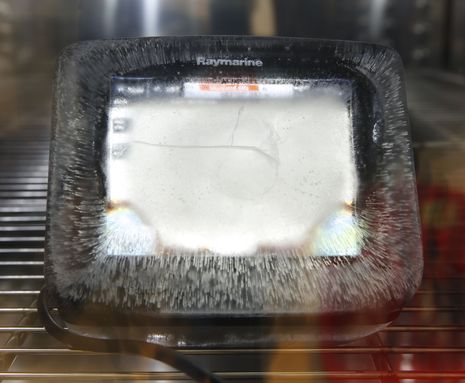 This frozen aSeries MFD has almost finished a two-day low temperature test, but that’s only the beginning of its suffering. Next it will run another two days in a high temperature cabinet with 85% relative humidity, and there’s still 19 more days of torture to Raymarine’s ERT (Early Reliability Test) Qualification Process. The quality of the testing tools and seriousness with which they’re used was as impressive as the Raymariner on-the-water lab, and I’m publishing more photos below because it’s reassuring to see what proper modern marine electronics have to go through before reaching our boats. But I’ll also attempt to describe the product innovation processes in play at Raymarine’s R&D center, which seemed equally impressive though much harder to photograph or quantify…
This frozen aSeries MFD has almost finished a two-day low temperature test, but that’s only the beginning of its suffering. Next it will run another two days in a high temperature cabinet with 85% relative humidity, and there’s still 19 more days of torture to Raymarine’s ERT (Early Reliability Test) Qualification Process. The quality of the testing tools and seriousness with which they’re used was as impressive as the Raymariner on-the-water lab, and I’m publishing more photos below because it’s reassuring to see what proper modern marine electronics have to go through before reaching our boats. But I’ll also attempt to describe the product innovation processes in play at Raymarine’s R&D center, which seemed equally impressive though much harder to photograph or quantify…
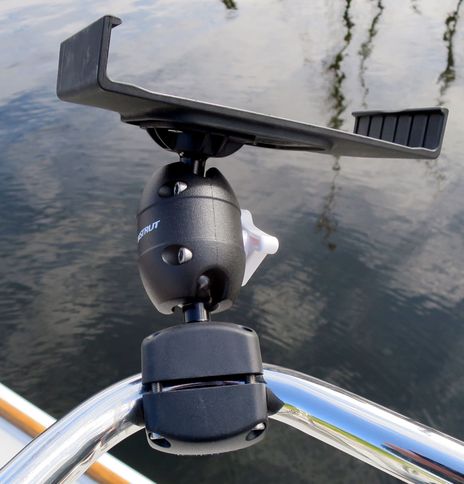 “Rokk” is a apt name for Scanstrut’s adjustable mount system. Due to the large surface area and fine machining of those metal-on-metal ball and socket joints, it’s easy to precisely position an attached MFD or iPad and then just a modest twist on the white handle will render the whole rig rock solid. I tested the Rokk Adjustable Rail Mount — note how well it handles curved 1-inch rail or helm pedestal pipe — with the Lifedge iPad case holder shown, but there’s also a Rokk Adjustable Deck Mount and either can accommodate top plates custom designed for various popular displays in the 5- to 7-inch screen range. Is Rokk better than RAM?
“Rokk” is a apt name for Scanstrut’s adjustable mount system. Due to the large surface area and fine machining of those metal-on-metal ball and socket joints, it’s easy to precisely position an attached MFD or iPad and then just a modest twist on the white handle will render the whole rig rock solid. I tested the Rokk Adjustable Rail Mount — note how well it handles curved 1-inch rail or helm pedestal pipe — with the Lifedge iPad case holder shown, but there’s also a Rokk Adjustable Deck Mount and either can accommodate top plates custom designed for various popular displays in the 5- to 7-inch screen range. Is Rokk better than RAM?
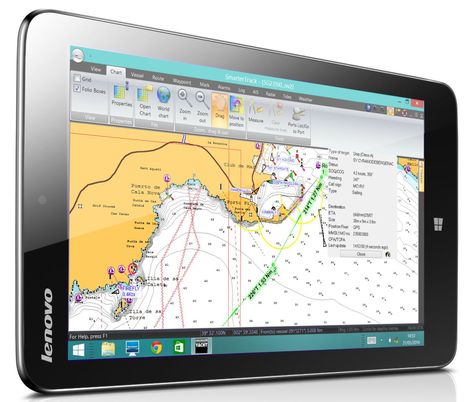 I first heard of the Lenovo MiiX 2 when Digital Yacht dubbed it a “best buy for boaters”; besides a low price of about $220, the 8-inch tablet is purportedly bright, fast, and able to run regular Windows navigation programs like DY’s own SmarterTrack. While an internal GPS enables standalone navigation, the DY team mainly envisions the tablet as a second station using NMEA 0183 or 2000 boat data (like the AIS seen above) provided over WiFi by one of its many black box hardware options. But then a look at the MiiX 2 on Amazon revealed a sailing reviewer who’s very ethusiastic about this tablet as his primary nav device, running free OpenCPN software…
I first heard of the Lenovo MiiX 2 when Digital Yacht dubbed it a “best buy for boaters”; besides a low price of about $220, the 8-inch tablet is purportedly bright, fast, and able to run regular Windows navigation programs like DY’s own SmarterTrack. While an internal GPS enables standalone navigation, the DY team mainly envisions the tablet as a second station using NMEA 0183 or 2000 boat data (like the AIS seen above) provided over WiFi by one of its many black box hardware options. But then a look at the MiiX 2 on Amazon revealed a sailing reviewer who’s very ethusiastic about this tablet as his primary nav device, running free OpenCPN software…
 Raymarine recently announced three new multifunction displays, extending the multitouch aSeries to 9- and 12-inch screen sizes, and the glass bridge gS Series to 19 inches (the proportions of my collage are approximate). Given four additional a9 and a12 models with digital sounder or Chirp DownVision built in and the fact that all these new MFDs can network with all the aSeries, cSeries (non touch), eSeries (hybrid touch), and gS models already available, is any other manufacturer offering so much choice? They all run the same software — now up to Lighthouse II, release 10 — so you may already be familiar with most of the features, but the new MFDs do have a few new hardware highlights, some of which I got to see in action aboard Raymarine’s remarkable testing vessel…
Raymarine recently announced three new multifunction displays, extending the multitouch aSeries to 9- and 12-inch screen sizes, and the glass bridge gS Series to 19 inches (the proportions of my collage are approximate). Given four additional a9 and a12 models with digital sounder or Chirp DownVision built in and the fact that all these new MFDs can network with all the aSeries, cSeries (non touch), eSeries (hybrid touch), and gS models already available, is any other manufacturer offering so much choice? They all run the same software — now up to Lighthouse II, release 10 — so you may already be familiar with most of the features, but the new MFDs do have a few new hardware highlights, some of which I got to see in action aboard Raymarine’s remarkable testing vessel…
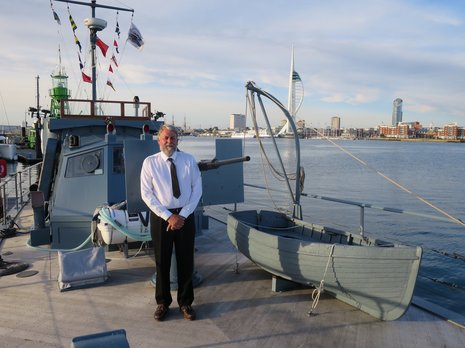 There’s much to report about my three day visit with the Raymarine product development team, but the impromptu kicker was a visit to HDML (Harbour Defense Motor Launch) #1387, and the vessel’s key story couldn’t be more timely. 70 years ago yesterday, well before D-Day H-Hour, 1387 headed toward Normandy loaded with electronics that helped her crew precisely mark the planned final channel to Omaha Beach, first for the minesweepers and then for the vast fleet of landing craft that left Portsmouth behind her. And today she’s headed for France again, this time with an all volunteer crew led by Alan Watson, the gentleman who so kindly showed me around last evening.
There’s much to report about my three day visit with the Raymarine product development team, but the impromptu kicker was a visit to HDML (Harbour Defense Motor Launch) #1387, and the vessel’s key story couldn’t be more timely. 70 years ago yesterday, well before D-Day H-Hour, 1387 headed toward Normandy loaded with electronics that helped her crew precisely mark the planned final channel to Omaha Beach, first for the minesweepers and then for the vast fleet of landing craft that left Portsmouth behind her. And today she’s headed for France again, this time with an all volunteer crew led by Alan Watson, the gentleman who so kindly showed me around last evening.
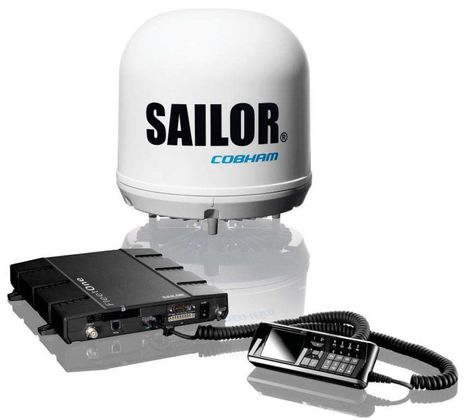 Boaters looking for a reliable, moderately fast satellite Internet connection for light and/or occaisional use have learned to be leery of Inmarsat. When FleetBroadband came out in 2009 — particularly the FB150 model with its easily installed 13.5-inch stabilized antenna — it seemed like a reasonably affordable option for bluewater cruising. This promise was confirmed in a terriffic Panbo review series conducted by Gram Schweikert as his family sailed from Maine to New Zealand with both KVH FB150 and an Iridium OpenPort antennas mounted on the spreaders. Note the friendly rate sheets published in Gram’s installation entry and how (with very careful data use) he found the FB150 quite useful out in Pacific at only about $100 to $150 a month in service charges. Unfortunately, the rates changed…
Boaters looking for a reliable, moderately fast satellite Internet connection for light and/or occaisional use have learned to be leery of Inmarsat. When FleetBroadband came out in 2009 — particularly the FB150 model with its easily installed 13.5-inch stabilized antenna — it seemed like a reasonably affordable option for bluewater cruising. This promise was confirmed in a terriffic Panbo review series conducted by Gram Schweikert as his family sailed from Maine to New Zealand with both KVH FB150 and an Iridium OpenPort antennas mounted on the spreaders. Note the friendly rate sheets published in Gram’s installation entry and how (with very careful data use) he found the FB150 quite useful out in Pacific at only about $100 to $150 a month in service charges. Unfortunately, the rates changed…
 Redoing almost all of Gizmo’s electronics has taken longer than I would have guessed last fall, when it seemed like a good idea to rip everything off the boat. And sadly I’m not done yet. But the hoped-for glass bridge theme is revealing itself and I like it a lot. But then again new equipment and even just re-installed old gear also means fresh opportunities for things not to work together correctly. In this entry I’ll go over much of Gizmo’s test setup for the next year and a half — though by design there’s room for more — and also note a couple of features that have worked well and not so well during recent shakedown cruises…
Redoing almost all of Gizmo’s electronics has taken longer than I would have guessed last fall, when it seemed like a good idea to rip everything off the boat. And sadly I’m not done yet. But the hoped-for glass bridge theme is revealing itself and I like it a lot. But then again new equipment and even just re-installed old gear also means fresh opportunities for things not to work together correctly. In this entry I’ll go over much of Gizmo’s test setup for the next year and a half — though by design there’s room for more — and also note a couple of features that have worked well and not so well during recent shakedown cruises…














